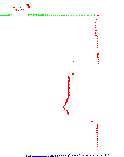The basic idea of labelling 3D points with semantic information
is to use the gradient between neighbouring points to differ
between three categories, i.e., floor-, object- and
ceiling-points. A 3D point cloud that is scanned in a yawing scan
configuration, can be described as a set of points
![]() given in a cylindrical coordinate
system, with
given in a cylindrical coordinate
system, with ![]() the index of a vertical raw scan and
the index of a vertical raw scan and ![]() the
point index within one vertical raw scan counting bottom up. The
gradient
the
point index within one vertical raw scan counting bottom up. The
gradient
![]() is calculated by the following equation:
is calculated by the following equation:
 |
The classification of point
![]() is directly derived
from the gradient
is directly derived
from the gradient
![]() :
:
1. ceiling-points: ¯ 1. floor-points:with a constant
2. object-points:
3. ceiling-points:
Applied to real data, this simple definition causes two
problems. As can be seen in Fig. ![]() (a)
noisy range data can lead to wrong classifications of floor- and
ceiling-points. Changing the differential quotient as follows
solves this problem:
(a)
noisy range data can lead to wrong classifications of floor- and
ceiling-points. Changing the differential quotient as follows
solves this problem:
|
![\includegraphics[width=45mm]{semantic_information_a}](img28.png)
![\includegraphics[width=45mm]{semantic_information_b}](img29.png)
![\includegraphics[width=30mm]{semantic_information_c}](img30.png)
The second difficulty is the correct computation of the gradient
across jumping edges (see Fig. ![]() (b)). This
problem is solved with a prior segmentation
[16], as the gradient
(b)). This
problem is solved with a prior segmentation
[16], as the gradient
![]() is only
calculated correctly if both points
is only
calculated correctly if both points
![]() and
and
 belong to the same segment. The correct classification
result can be seen in
Fig.
belong to the same segment. The correct classification
result can be seen in
Fig. ![]() (c). Fig.
(c). Fig. ![]() shows a 3D
scan with the semantic labels.
shows a 3D
scan with the semantic labels.
![\includegraphics[width=40mm]{single_scan_view2}](img33.png)
![\includegraphics[width=40mm]{single_scan_view3}](img34.png)
|